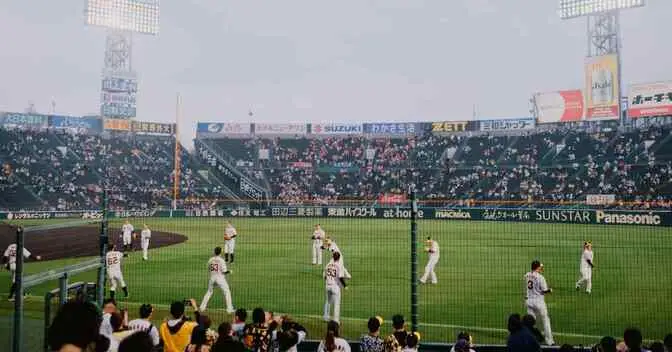
You see, this is a trick play in baseball where players need to know their jobs and positions around the field. Each player also has a job to do, and by numbering the players in a way that indicates where they should be and what they should be doing, we can all keep track of them. These digits are called baseball game positions; they are uniform throughout the game to help players and coaches communicate and strategize better. We’ll cover infield and outfield baseball positions by number in this article, providing you with a more comprehensive understanding of them.
Positions In Baseball By Number -Position Rundown:
How many players are on the field in baseball? The first thing any beginner player needs to take the time to learn is the meaning of baseball field position numbers. These numbers are assigned to different positions on the field, such as pitcher, catcher, infielders, and outfielders. We need to assign numbers to each position so that players, coaches, and umpires can all communicate promptly and effectively with each other. For example, the pitcher will always be described as “1,” the catcher as “2,” and the numbers increase as they move across the field.
Baseball Numbers on Field and Shapes of Baseball Positions:
Pitcher (1):
The pitcher is the player who is responsible for throwing the ball to the batter. They perform the most critical function, which is to start the play,” explains the announcer. All they are attempting to do is control the strike zone, record outs and set the tone of the game.
Catcher (2):
The catcher is the player behind home plate; he is the receiver of pitches, the blocker of balls, and a helper to fielders on defense. The catcher baseball position is challenging physically and requires quick reflexes and excellent leadership skills.
First Baseman (3):
First baseman – First base is the first of four bases to which a runner can advance through offensive play; first base itself is therefore the second base. They would be the tallest player on the team, as their primary role is to catch high throws from the infield.
Second Baseman (4):
(First base-second base)The second baseman plays between second base and first base. They’re fast and nimble, for taking balls out of the dirt and turning double plays. They also cover second base on stolen base attempts.
Third Baseman (5):
The third baseman also stands at third base and is responsible for fielding ground balls on the line. They have to be fast with a strong arm to throw the ball to a long distance to first base.
Shortstop (6):
Where is shortstop? The shortstop is the most physically turned player on the infield, located between second and third base. The shortstop baseball position is alsoa defensive position that requires speed, agility, and a strong arm are needed when turning double plays.
Left Fielder (7):
The left fielder plays in the left field baseball area. They are tasked with catching fly balls, fielding ground balls, and throwing accurately to infielders. Left field is a vast expanse, and to cover it, fielders baseball have to be able to shuffle and scoot their feet, and also have a cannon for an arm. Where is left field in baseball? It’s to the left side of the field, well beyond the infield.
Center Fielder (8):
The center fielder plays in the middle of the outfield and covers a lot of ground. They are usually seen as the “captain” of the outfield and tell the left and right fielders when to cut.
Right Fielder (9):
In baseball, the right fielder in baseball plays in right field, a position responsible for catching fly balls, stopping line drives, and backing up the first baseman. Where is right field? It is the opposite end of the left field from the foul line.
Designated Hitter (DH):
In leagues such as the American League, the DH position in baseball is a Designated Hitter who hits in place of the pitcher but does not play defense. Above all, this position is a filler that doesn’t require much more than being able to stand in place defensively.

Baseball Field Layout: A Visual Guide
The baseball position diagram with positions will also give you a visual of where each player is during a game. It’s also worth knowing that the positions can be fluid, depending on the context of a game, and that the roles tend to stay this way:
Infield baseball positions:
Infielders in baseball cover the areas of the baseball diamond in the middle, including pitcher, catcher, first baseman, second baseman, shortstop, and third baseman.
The outfield positions:
They are the left fielder, center fielder, and right fielder (or right outfielder baseball), who play in the left, center, and right fields, respectively. In baseball positions outfield are responsible for catching fly balls (balls hit in the air) or stopping and catching balls hit along the ground.
The Importance of the Number Position of Baseball:
For that reason, each of the baseball numerical positions exists to make the play on the field easier. For instance, a coach might shout a “1-6-3” play, and that would mean the pitcher (1) throws to the shortstop (6), who then throws to the first baseman (3) to turn a double play.
Knowing where is left field in baseball is essential in understanding your defensive duties. The baseball outfield positions are different from infield, because the outfielders traditionally receive the balls from greater distances.
Baseball Diagram Field and Position Numbers:
The numbers on the first diagram are more common with modern-day baseball fields – numbers two and three are the way the fields were if you grew up playing baseball before the 1950s.
Teams often use baseball diamond with positions to plot their strategy. Understanding the baseball positions in the outfield and their numbers helps players know where they should be at all times.

Conclusion:
The Baseball Positions by Number system makes it easy for you to explain this to all of your players that are currently on the field. Whether it be on the mound, in left field or out in right field, every player is crucial for the success. Whether you’re just a fan, a player or a coach, you need to know more than just that baseball contains a field and some positions on it to appreciate and play the game. And remember, knowing what players are supposed to be doing on the court can help you enjoy the game that much more.
FAQs:
How many people play at once in baseball?
There are nine players on the field at a time during a baseball game: 1 pitcher, 1 catcher, 4 infielders, and 3 outfielders.
Where in the diamond are both baseball positions?
Players have an assigned fielding position: pitcher (1), catcher (2), first baseman (3), second baseman (4), third baseman (5), shortstop (6), left fielder (7), center fielder (8), and baseball field right fielder(9).
What are the positions in softball?
Position numbering is also used in softball. The softball position numbers do not change significantly, although the infield positioning is slightly different in some cases.
What is a DH baseball position?
The DH hits for the pitcher and does not play a position defensively.
